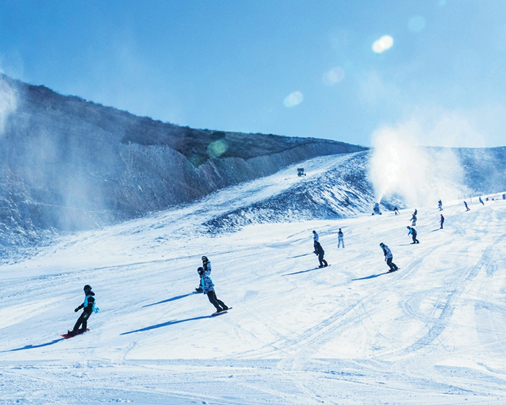Fine traditions upheld during national holiday
Updated: 2025-02-12
Shanxi province puts on dazzling display to celebrate Spring Festival
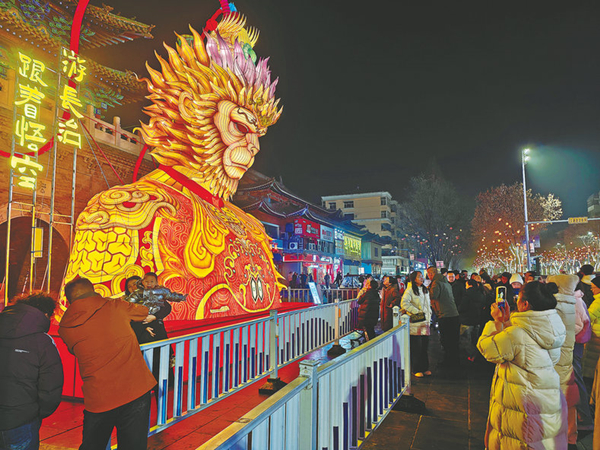
Some 1,000 lanterns illuminate the night sky in Changzhi, Shanxi province, on Feb 2. [Photo by Shen Jinguang/For China Daily]
The past few weeks marked the first celebration of Spring Festival, or Chinese New Year, after it was inscribed on UNESCO's Representative List of the Intangible Cultural Heritage of Humanity on Dec 24.
According to a UNESCO document, the festival has been included for its wide range of rituals and unique cultural elements that engage all of Chinese society. These include prayers for good fortune and family reunions, activities planned by elders and public events organized by communities.
UNESCO noted that the traditional knowledge and customs associated with Spring Festival are passed down informally within families and communities, as well as formally through the educational system, promoting family values, social cohesion and peace, while providing a sense of social identity.
It also emphasized that the festival embodies harmony between humans and nature, and contributes to sustainable development.
As one of the cradles of Chinese civilization, the North China province of Shanxi is the place where centuries-old traditions and cultural elements are still alive in people's daily lives. And this is especially true during the Spring Festival period.
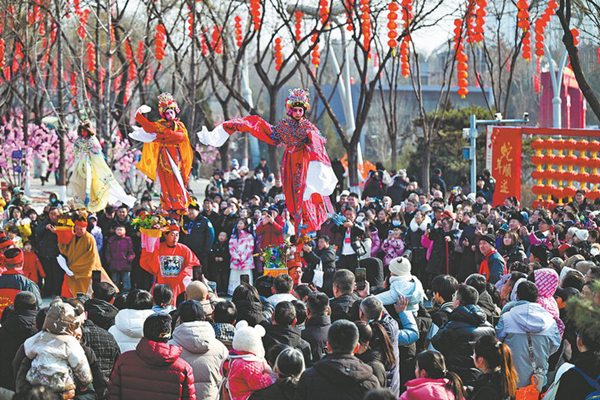
Crowds gather to watch the traditional beigun intangible cultural heritage performance in Shanxi during the holiday. The performance features a child in costume bound to the top end of an iron rod. The lower end of the rod is secured to a man's back. As the man walks, he moves to the beat of drums, and the child sways and acts out theatrical stories, creating a visual spectacle. [Photo by Li Zhaomin/For China Daily]
Varied celebrations
Spending several days in Shanxi during Spring Festival can give people an immersive experience of the variety of traditions, cultural elements and values associated with the holiday, according to locals and visitors alike.
In Shanxi, as well as other regions of the country, the Spring Festival celebrations last for more than a month.
The celebrations start on Laba Festival, which is the eighth day of the 12th month on the lunar calendar, which fell on Jan 7 this year.
For more than 2,000 years, Laba Festival has been an occasion to worship ancestors and the gods and to pray for a good harvest and good fortune. The tradition involves a number of practices like making laba garlic.
The making of laba garlic is simple – garlic cloves are pickled in jars of vinegar. The cloves usually turn green before Chinese New Year's Eve, ready to be served along with the famed jiaozi dumplings for family reunion dinners.
Simple as it is, making tasty laba garlic is dependent on high-quality vinegar. Fortunately, Shanxi is the place where the country's best matured vinegar is produced.
On the morning of Jan 7, people lined up in front of an outlet of a time-honored vinegar business in Taiyuan, the provincial capital.
They used various containers to collect vinegar from a huge jar at the outlet. The sour-sweet fragrance of matured vinegar permeated the air and could be smelt hundreds of meters away.
"That's the smell we Shanxi people love in particular," said a Taiyuan resident surnamed Wang. "That's the smell of New Year we have been so familiar with since childhood."
After that day, the festive atmosphere prevails throughout the province, which is demonstrated in practices such as decorating homes, streets and communities with Spring Festival couplets, lanterns and other auspicious ornaments; preparing local dishes such as flowery buns; and varieties of folk activities such as stilt walking, molten iron firework shows and performances of local operas.
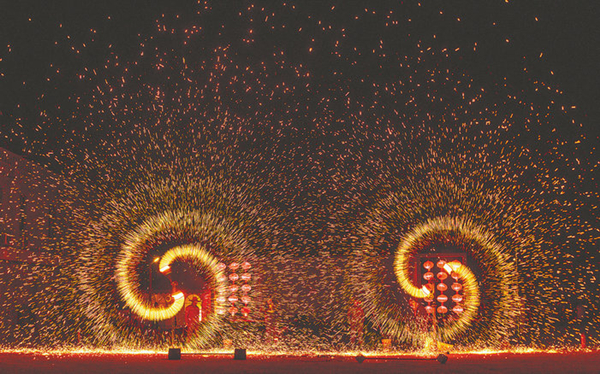
Folk artists perform the traditional datiehua (molten iron fireworks) show in Zuoquan county on the night of Jan 30. [Photo by Zhang Wenjun/For China Daily]
A molten iron fireworks show, which is also known as datiehua among locals, is popular in Shanxi's cities such as Yuncheng and Jincheng.
This practice involves spraying molten iron into the air, which is said to be able to scare away demons and other evil spirits.
On Jan 31, a datiehua show was held in Yuncheng's Yanhu district, attracting an audience of thousands.
At a public square near the Yanhu Lake, which was surrounded by crowds on three sides at a safe distance, eight big pots with molten iron were placed near bonfires. Hundreds of performers danced beside these bonfires to the rhythm of drums and gongs.
When the rhythm intensified, the datiehua show began. Performers sprayed the scorching iron liquid into the air, producing a shower of magnificent sparks, just like fireworks. Among the audience members, children watched and jumped with excitement, while the adults raised their phones to capture the dazzling scene.
According to a performer, there are more than a dozen ways of spraying molten iron into the air, with tools such as an iron ladle, wire and a board.
There are also plenty of opera shows throughout the province during Spring Festival.
As one of the sources of the country's opera arts, Shanxi is dubbed "a cradle of Chinese operas", with its numbers of ancient opera stages and opera genres both ranking first in the nation.
The main stage for the CCTV Spring Festival opera evening gala on Jan 30 was set up in the old county seat of Taiyuan. Renowned performers of local opera arts, ranging from Jinju Opera, Puju Opera to Shangdang Bangzi and Beilu Bangzi, offered an audiovisual feast to audiences throughout the country.
In addition, Shanxi is home to 182 intangible cultural heritage items at the national level and 942 ICH items at provincial level. Most of these cultural assets were presented to audiences through various shows during this Spring Festival.
During Spring Festival, the charm of Shanxi cultural heritage can also be experienced by foreigners.
On Jan 22, a day known as xiaonian or Little New Year in northern China, Gojayeva Bagul from Turkmenistan and Mutangay Jesteben Beni from the Democratic Republic of the Congo attended a workshop at Shanxi Museum in Taiyuan.
At the workshop that featured a range of ancient craft skills, the two showed a special interest in the making of new year paintings based on wood carvings.
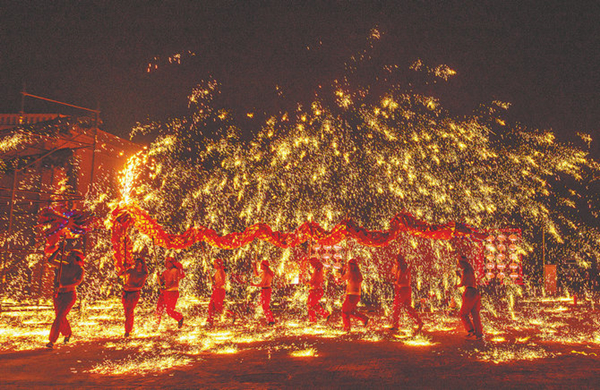
Performers dressed in colorful attire stage a dragon dance in front of a museum in Zuoquan county, Shanxi province, during this year's Spring Festival holiday. [Photo by Zhang Wenjun/For China Daily]
Modern adaptation
Chinese New Year celebrations have been conducted in Shanxi, as well as the rest of the country, for thousands of years. While preserving culture and values throughout history, the celebrations have changed with the times and adapted to the modern tastes of people.
One example is jifu, the practice of collecting the Chinese character of fu, or fortune, in various forms and styles, and presenting them on social media to convey good wishes.
Companies or other social entities also used the jifu practice as a method of promotion. For example, renowned Chinese online payment company Alipay launched a jifu event on Jan 20. It distributed 28 sets of fu cards featuring various fu characters and various themes as the background behind the characters. One set of such cards featured Shanxi's cultural and natural attractions, aiming to promote Shanxi's tourism.
The Shanxi-themed cards highlighted five renowned attractions in the province, namely Yungang Grottoes and Huayan Buddhist Temple in Datong, Yuhuang Temple in Jincheng, Xuankong Temple in Hunyuan, and Xiaoxitian in Xixian.
While offering brief introductions of the attractions to help people with their tour planning, the cards have other practical benefits. On showing the cards, tourists can enjoy reductions in bus and subway fares or the entrance fees to scenic areas. They are also able to get souvenirs for free.
Sheng Yijiao, a Taiyuan resident, said she had collected all the Shanxi-themed fu cards. "I'm happy that Shanxi's excellent cultural and tourism resources can be better recognized among people throughout the country via the process of collecting fu cards," Sheng said.
Touring is now a popular way for people to spend Spring Festival. As a popular cultural tourism destination, Shanxi is a major beneficiary of the Spring Festival tourism boom. Statistics show that the number of Shanxi-related online bookings during the period has increased 27 percent from a year ago, while bookings from overseas tourists rose 33 percent year-on-year thanks to China's 240-hour visa-free policies for transit tourists from many countries.
In Shanxi, there are also many helpful measures for overseas tourists, including the growing number of outlets for currency exchange and the upgrading of ATMs to allow foreign bank card holders to withdraw cash.
A major destination for cultural tourism in Shanxi, Shanxi Museum in Taiyuan has used modern technologies to attract visitors.
At the CCTV Spring Festival opera evening gala on Jan 30, the museum introduced itself to the audience in an innovative manner. With the help of digital technologies, the Jin Dynasty (1115-1234) terracotta opera-playing figurines, for instance, were revived, sitting among the audience to enjoy operas of modern times.
Wang Jianqiang, a Taiyuan resident, has been a volunteer in the museum for more than 10 years.
"Over the past decade, I have witnessed how the museum has become increasingly popular among tourists," Wang Jianqiang said. "The success can be partially attributed to the innovations driven by modern technologies, including more online promotions to attract visitors and the use of digital technologies inside the museum to enhance visitors' understanding of the exhibits and their related history."
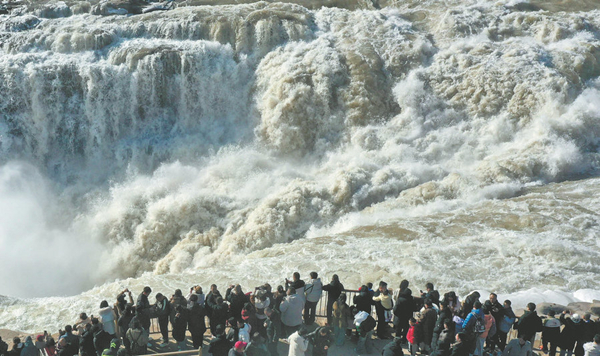
Hukou Waterfall on the Yellow River in Jixian county, Shanxi province, with its roaring torrents and stunning icefall rainbows, attracts many tourists during the Spring Festival holiday. [Photo by Lyu Guiming/For China Daily]
Safety ensured
Spring Festival is the occasion for family reunions. But while most families are getting together to celebrate, there are some people who are still on duty to ensure public safety.
"As the Spring Festival period features the biggest flow of people in a year, safety is a major concern," said Zhang Yubing, a police officer in Yangcheng county.
Zhang is the head of a police station in Yangcheng's Manghe township. The station is responsible for 18 villages and a population of 13,000.
The eight-day Spring Festival holiday, spanning Jan 28 to Feb 4 this year, is a period dedicated to family reunions. Most people left their work duties behind.
But this was not the case for Zhang and his eight colleagues; they worked eight days on shifts.
"The big traffic flow, drunken driving and the risks arising from fireworks are among our major concerns," Zhang said.
While some police officers were on the roads to ensure traffic safety, others were busy visiting villages, cautioning residents about fireworks, drinking and other risks, according to Zhang.
"We walked more than 20,000 steps a day during the period," Zhang said.
Also on duty during the national holiday were customs officers at Taiyuan Wusu International Airport, medics at various hospitals throughout Shanxi, and community officials, to name just a few.
Zhang Qi contributed to this story.


